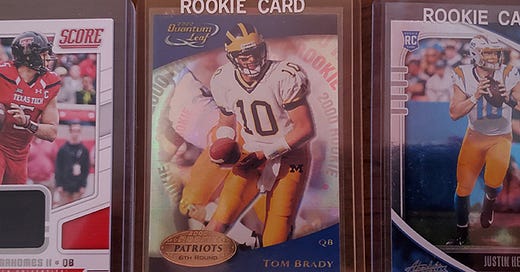How Bill Ripken Fueled An Error Card Craze
Errors in sports cards aren't unusual, but one in particular fueled interest -- and might have fueled some companies going overboard with variations.
In 1989, within weeks of Fleer releasing its baseball set, some collectors noticed something unusual about the card featuring Cal Ripken's younger brother.
That card fueled interest in the set, led to multiple variations of the card and sparked what became known as the "error card" craze.
The first printing of the 1989 Fleer baseball set featured a card of Baltimore Orioles second baseman Bill Ripken. The photo featured a typical posed shot, with Ripken holding the bat over his shoulder.
What was not typical about this shot was the knob of Ripken's bat featured an obscene phrase.
At the time, Ripken denied writing the phrase on his bat, claiming it was a prank by teammates. Years later, Ripken admitted to having written the phrase, but did so to make that bat identifiable from others left in front of his locker.
He said he was approached by a photographer for a photo, and grabbed the bat without realizing it was the one with the phrase.
You can read more about this famous "error card," but Ripken blames Fleer for what happened, and even claims that Fleer enhanced the writing on the bat so people would notice it.
Some may not believe Ripken's claim, but when you look at what was going on with errors at the time, he may be on to something.
Errors in baseball and other sports cards set aren't unusual. In 1981, Donruss and Fleer rushed their first sets onto the market, with cards filled with typos and, in some cases, misspelled names. In one case, Fleer misspelled the name of Fernando Valenzuela, the Los Angeles Dodgers pitcher who broke onto the scene in 1981, though the company never corrected that error.
But by the time 1989 rolled around, errors and corrections were popping up more frequently, and often happening to the most notable names in MLB.
For starters, Fleer released multiple versions of the Bill Ripken card to cover up the obscene phrase, to include a black circle over the knob, scribbling and what appears to be "white out" smeared over the knob.
Then there was Upper Deck's first ever baseball set in 1989, in which Dale Murphy's card had a reversed negative, or a case of the photo being flipped around so it looks like a mirror image.
In 1990, the first printing of the Donruss set had a rookie card for Texas Rangers outfielder Juan Gonzalez with a reversed negative, plus two Nolan Ryan cards -- one recognizing his 5000th strikeout and the other a "King of Kings" career tribute card -- with backs that were switched, plus a third variation of the 5000th strikeout card with no number on the back.
Jump over to football, with Pro Set rushing to get its first set onto the market, and it was filled with errors. The most notable may be for John Elway's card, in which the section listing how the team acquired the player said "drafted 1st round, '83." While Elway was drafted that year, the Denver Broncos acquired him by trade shortly after the 1983 draft.
There were other errors that popped up in Pro Set's product that were corrected, with one of the more obscure variations being for Gizmo Williams, in which the word "football" was misspelled as "footbal."
The following year, Pro Set had an unusual "error" in the card for Fred Marion of the New England Patriots, in which I will just say "see for yourself" with what's going on with San Francisco 49ers receiver John Taylor in the background.
Back to baseball, the 1990 Topps set featured a rookie card for Chicago White Sox first baseman Frank Thomas, but the card had no name on the front, though the error was corrected early in the print run.
Then there's basketball, in which the 1990-91 NBA Hoops set featured a variation for the card of Orlando Magic player Sam Vincent. It's notable because the original card featured Michael Jordan, only Jordan was wearing a jersey with No. 12 on it, instead of his usual No. 23 (his jersey was stolen before the game in question). The "corrected" version is a different photo of Vincent by himself.
With so many errors and variations on the market, there were plenty of collectors who believed that the card companies intentionally made them to boost interest in the product.
In some cases, I suspect the errors were honest oversights, but in other cases, it's hard to argue the companies didn't intend for variations to exist.
Pro Set, in fact, made a habit of updating football cards when players were traded, and Topps, which usually corrected errors only if they were significant, announced a number of minor corrections to cards in its 1991 set to commemorate its 40th anniversary of producing baseball cards.
By this point, interest in errors and variations had subsided. Most such variations aren't worth much, though a few still hold some interest for collectors today, either because they are truly difficult to find (the Thomas card from 1990 Topps is a good example) or because they are truly unique (the Vincent card with Jordan wearing No. 12 is one Jordan collectors will likely want).
There are still a few "error" cards that slip by the companies. A more recent example is 2006 Topps, in which card #297 of Alex Gordon was pulled because Gordon hadn't made his major league debut. At that point, MLBPA required card companies, in sets it licensed, to not produce a card for a player until he actually played a major league regular-season game.
But the craze that started in the 1980s, and truly went out of control when Bill Ripken's infamous bat phrase came along, has died out -- a prime example of how some crazes in sports card collecting don't last.



